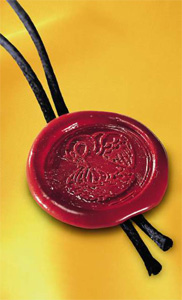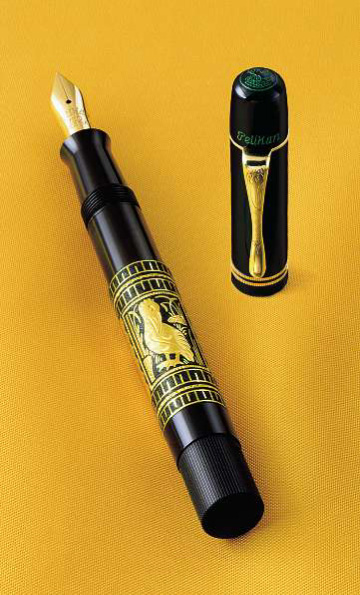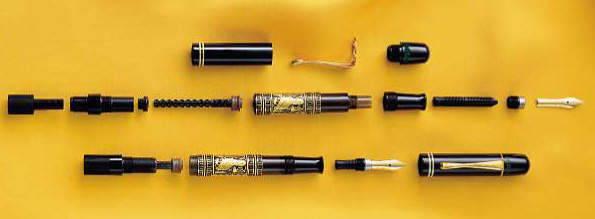|

Introduction
The new Toledo pen is the last in the limited series by Pelikan entitled
"Originals of their time." The pens in this series are replicas
of the first fountain pens available with a piston mechanism - the Pelikan
100.
The pens were first produced in 1929, and were later replaced by model
100N, 400, and the models now familiar to modern collectors. In the previous
releases in the series Pelikan did an admirable job of duplicating the
exact dimensions and weight of the original. While I only dream of owning
a real vintage 100 Toledo (or T111 as it was called) I believe this to
be a faithful replica. The T111 was available between 1931 and 1937 while
the style of the 100 pen was available between 1929 to 1944. The other
pens from this limited edition series are: the 101 - jade green and lapis
blue versions; 111 - gold barrel and black cap; and 110 - white gold cap
and barrel. Although they have different numerical designations, these
pens are identical in dimension to the 100.
Packaging
 The
packaging is similar to the blue and green limited edition pens. There
is an outer white box with a little label indicating the nib size. Inside
this box is another paper box, but this time colored and decorated with
the Pelikan logo and limited edition text. Inside this box there is a
slight difference to the other editions. The 101 editions had a hard box
and booklets inside this box. The Toledo has these sheathed in a silky
black pouch. This adds to the luxurious experience one is having while
opening the whole package for the first time. Inside the pouch are the
booklets, one containing the guarantee and card with the limited edition
number (mine is 37/1100). The second booklet describes the history of
the pen, as well as the traditional metalworking techniques used by the
artisans in Toledo. The box actually containing the pen is a hard lacquered
shell with the "1931" limited edition logo applied to the top,
as well as other text. Inside one sees the Toledo resting peacefully on
a bed of silky fabric that is similar to the pouch covering the box. Also
inside the box is a golden plaque with the limited edition number and
red wax sealed with the Pelikan emblem. This is the same emblem etched
on the cap of the pen. The
packaging is similar to the blue and green limited edition pens. There
is an outer white box with a little label indicating the nib size. Inside
this box is another paper box, but this time colored and decorated with
the Pelikan logo and limited edition text. Inside this box there is a
slight difference to the other editions. The 101 editions had a hard box
and booklets inside this box. The Toledo has these sheathed in a silky
black pouch. This adds to the luxurious experience one is having while
opening the whole package for the first time. Inside the pouch are the
booklets, one containing the guarantee and card with the limited edition
number (mine is 37/1100). The second booklet describes the history of
the pen, as well as the traditional metalworking techniques used by the
artisans in Toledo. The box actually containing the pen is a hard lacquered
shell with the "1931" limited edition logo applied to the top,
as well as other text. Inside one sees the Toledo resting peacefully on
a bed of silky fabric that is similar to the pouch covering the box. Also
inside the box is a golden plaque with the limited edition number and
red wax sealed with the Pelikan emblem. This is the same emblem etched
on the cap of the pen.
Pen
Overall the pen is a joy to use. This is a thin and light pen, very different
from current models, both from Pelikan and from other brands. Many readers
may be familiar with the popular Pelikan 600 model. This is a much smaller
pen. It is in fact smaller than the 400 model. While one may be put off
by the size (4.5" capped, 0.5" thin), consider that the pen
is a huge 6.25" when posted. This creates a delightful writing experience.
With pen in hand, gently touching the paper, one can experience the transition
from quill to dip pen to fountain pen. And when the pen is capped it is
a conveniently small package that fits in any pocket. I will go into each
detail of the pen below.
 Nib/Feed Nib/Feed
The nibs on all of the "originals" series pens are very different
from their vintage counterparts. While they have a vague resemblance,
one only needs to look closely to see the differences. The nib is 18kt
gold, with the Pelikan name printed over it. It has a different shape,
making it look shorter and wider than the vintage nibs, and is nowhere
near as flexible. The nib is buttery smooth on paper, while the vintage
nibs have a little more tooth. The ink flow is rather generous on my vintage
100s, while on this pen it is just enough. I personally prefer the vintage
nib, but this modern nib is in my opinion superior to the regular production
models. The booklet claims that each pen is hand adjusted and tested,
and it shows. The pen has that perfect flow and smoothness that is typically
only seen after a pen has visited a 'nibmeister.' The feed on the vintage
models is made of ebonite and has 3 rather large vanes (the slits on the
underside of the feed) which run longitudinally from the section to the
tip of the nib. The modern feed appears to be made of plastic with more
numerous, thinner vanes running horizontally. The modern feed is very
similar to that found on other modern Pelikans. In addition, the whole
nib unit does not screw in as deeply into the section as the vintage ones
do. This does not affect the functionality of the pen in any way besides
being a cosmetic difference.
Barrel
The barrel containing the piston mechanism is made of brown celluloid.
However, it is mostly covered by the fabulous Toledo engraving which exposes
only a small segment serving as an ink view window. The Toledo engraving
is beautifully done with gold plating highlighting the Pelikan figures.
Examining this pen with a 10x loupe shows even finer etchings on the black
portion of the barrel adding an 'aged' matte finish. One can see this
is all manually done, as the lines have the minor imperfections idiosyncratic
of an engraver's hand. If I had to sum it up with one word I would say
'exquisite.'
The section is made in black celluloid and does not attach seamlessly
to the barrel. One can definitely see the separating line where the section
becomes the barrel. My vintage pens, with hard rubber sections and celluloid
barrels, do not have this division, and seem to be made entirely of one
piece. Perhaps with age the connection will get smoothed. After all, the
vintage pens have been through over seventy years of writing.

Pelikan Toledo exploded view
Piston
The ridged piston turning knob is made of hard rubber and looks almost
identical to the vintage one, except for the imprinted arrow to show the
turning direction. The modern pen has a slightly larger and crisper arrow,
while the vintage ones have a finer and smaller arrow. The piston mechanism
is again a modern version of the original, with a plastic seal (rather
than cork). This makes the pen more reliable in terms of maintenance as
there is no cork to dry out. Although I have not conducted any scientific
experiments I believe the modern version holds marginally less ink than
the vintage 100. With the vintage pen's generous flow and fractionally
larger ink capacity I believe the actual "words per fill" to
be equivalent between the two.
Cap
The cap and cap tip are both made of black celluloid. If one is in doubt,
just uncap the pen and hold the cap end close to your nose. The strong
smell of camphor will quickly assure you of the material. There are two
cap rings, but they differ from the regular models in that they are fluted
instead of smooth, nicely complimenting the Toledo engraving. The cap
tip has the word "Pelikan" engraved and filled in green, and
the limited edition number engraved but left unfilled behind it. The Pelikan
logo is aligned with the clip, showing the attention to detail when assembling
the pen. On the tip of the cap one sees the traditional Pelikan emblem
with a hatched nest and four baby pelicans. This logo was later changed
to a more 'streamlined' version in the model 100 pens. That logo, with
only two pelicans, is still in use today. I like to think that two flew
away to start their own families, rather than it being a case of survival.
I am sure it was tough for baby pelicans back in the 1930s. :)
Clip
The clip is the only thing I would change on this pen. Yes, even before
the nib. The reason is as follows: The nib is a personal preference, and
where I might prefer a vintage nib, another might prefer a modern nib.
Functionally they are the same, both renditions writing well. The clip
on the other hand, is engraved on the original pen. On this replica it
is 'stamped.' This means that although the design is the same, the engraving
has a much fainter appearance and seems out of balance with the rest of
the pen. It is nowhere near as well done as the Toledo engraving and it
is a shame that Pelikan decided to take this route. It almost feels like
I could smooth off the engraving with my thumb. Besides this detail, the
clip is gold plated and holds firmly in the pocket. The plating is a little
more white than the Toledo engraving, that being a more rich yellow. At
hands length this color difference is almost imperceptible.
Conclusion
All faults aside, this is a beautiful pen. As a vintage Pelikan collector
I could not let this one pass and would buy it all over again after having
touched and used it. Not only is it a faithful reproduction of what is
considered the "holy grail" to Pelikan collectors, it is also
a good writer and considerably more robust and affordable than the real
thing. Although the price is higher than the green and blue editions,
the Toledo engraving warrants it. I believe any Pelikan fan should have
a 100 in their collection, whether it is of original vintage production
or modern limited edition.
Photos: Pelikan courtesy of Chartpak. |